AMD FX-8320E CPU Review: The Other 95W Vishera
by Ian Cutress on January 13, 2015 10:00 AM ESTF1 2013
First up is F1 2013 by Codemasters. I am a big Formula 1 fan in my spare time, and nothing makes me happier than carving up the field in a Caterham, waving to the Red Bulls as I drive by (because I play on easy and take shortcuts). F1 2013 uses the EGO Engine, and like other Codemasters games ends up being very playable on old hardware quite easily. In order to beef up the benchmark a bit, we devised the following scenario for the benchmark mode: one lap of Spa-Francorchamps in the heavy wet, the benchmark follows Jenson Button in the McLaren who starts on the grid in 22nd place, with the field made up of 11 Williams cars, 5 Marussia and 5 Caterham in that order. This puts emphasis on the CPU to handle the AI in the wet, and allows for a good amount of overtaking during the automated benchmark. We test at 1920x1080 on Ultra graphical settings.
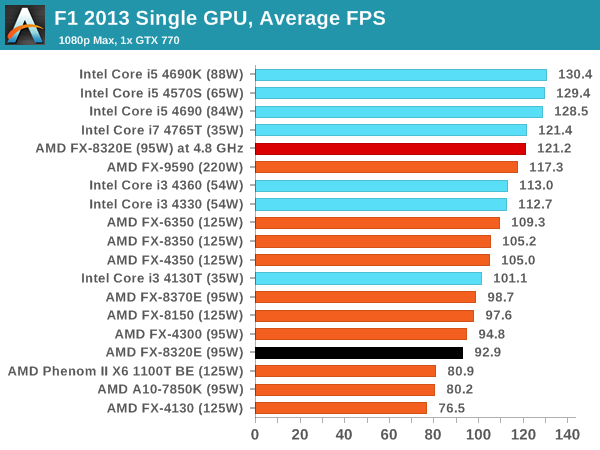
In both single and dual GPU cases, the stock performance of the FX-8320E falls behind the i3 CPUs by a 10-20 FPS margin, perhaps being noticeable on 120 Hz monitors. The minimum FPS on a single GPU still retains above 60 FPS, which is a plus.
Bioshock Infinite
Bioshock Infinite was Zero Punctuation’s Game of the Year for 2013, uses the Unreal Engine 3, and is designed to scale with both cores and graphical prowess. We test the benchmark using the Adrenaline benchmark tool and the Xtreme (1920x1080, Maximum) performance setting, noting down the average frame rates and the minimum frame rates.
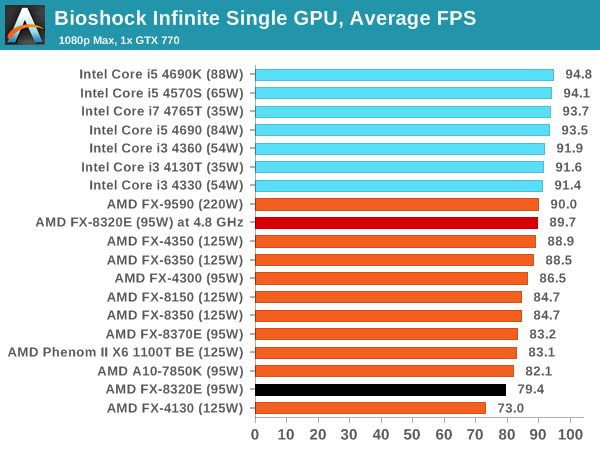
While average frame rates almost appear to be CPU agnostic, there is a clear AMD/Intel split here. More interesting is the minimum FPS results which seem to rely on IPC.
Tomb Raider
The next benchmark in our test is Tomb Raider. Tomb Raider is an AMD optimized game, lauded for its use of TressFX creating dynamic hair to increase the immersion in game. Tomb Raider uses a modified version of the Crystal Engine, and enjoys raw horsepower. We test the benchmark using the Adrenaline benchmark tool and the Xtreme (1920x1080, Maximum) performance setting, noting down the average frame rates and the minimum frame rates.
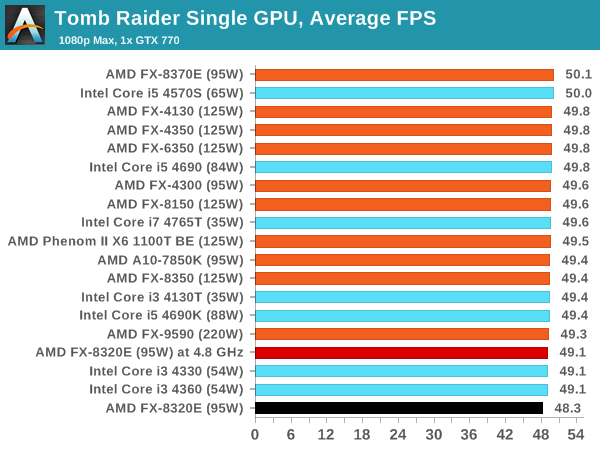
Tomb Raider still comes across as purely CPU agnostic.
Sleeping Dogs
Sleeping Dogs is a benchmarking wet dream – a highly complex benchmark that can bring the toughest setup and high resolutions down into single figures. Having an extreme SSAO setting can do that, but at the right settings Sleeping Dogs is highly playable and enjoyable. We run the basic benchmark program laid out in the Adrenaline benchmark tool, and the Xtreme (1920x1080, Maximum) performance setting, noting down the average frame rates and the minimum frame rates.
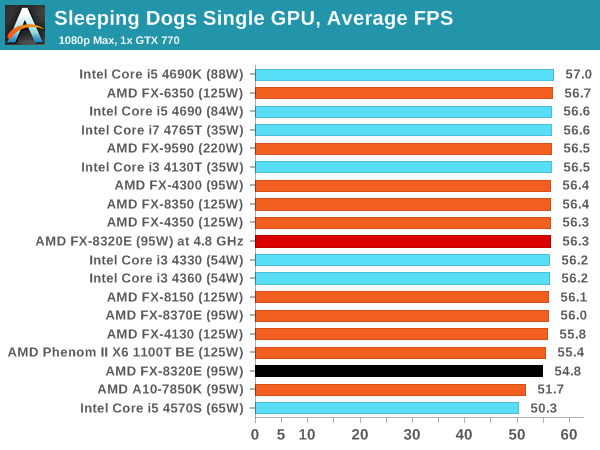
Single GPU usage puts the 8320E in the ballpark, but moving to dual GPUs sees an uplift in terms of the i5 CPUs for high refresh rate screens, albeit with the extra cost associated.
Battlefield 4
The EA/DICE series that has taken countless hours of my life away is back for another iteration, using the Frostbite 3 engine. AMD is also piling its resources into BF4 with the new Mantle API for developers, designed to cut the time required for the CPU to dispatch commands to the graphical sub-system. For our test we use the in-game benchmarking tools and record the frame time for the first ~70 seconds of the Tashgar single player mission, which is an on-rails generation of and rendering of objects and textures. We test at 1920x1080 at Ultra settings.
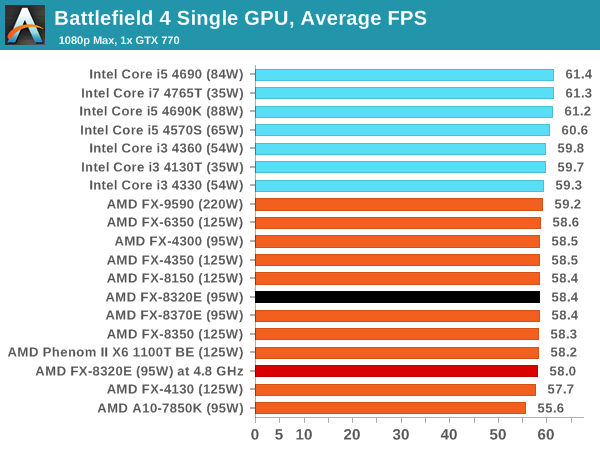
Single GPU shows little difference (despite a clear AMD/Intel separation line), but in dual GPU mode an i3 will make a 17 FPS rise, moving to 27 FPS with the i5 and more relevant to high refresh displays.















92 Comments
View All Comments
cobrax5 - Wednesday, January 14, 2015 - link
I don't think they were saying Intel chipsets work with AMD, they are saying Intel has a greater variety of options from value to performance.I'm actually a fan of AMD keeping their chipset as long as possible as it allows people to update just their old CPU. However, 6 years is a bit long. They really do need to completely revamp it. I guess they are just buying time until skybridge or whatever the ARM/x86 is called...
eanazag - Tuesday, January 13, 2015 - link
Budget chipset is the 970. Real budget is a different AMD CPU like the AM1 socket or APU FM2 sockets.That is just how AMD does it, which is different than Intel. Intel offers 2 sockets. AMD has 3.
hojnikb - Tuesday, January 13, 2015 - link
Not really. 970 is more like a midrange chipset like h97 with intel. You can't find cheap board with 970 like you can with intel.And having a different socket for low/midrange also kills it. Basicly you cant combine cheap board with a fast cpu like you can with intel.
Amd should just stick to one socket. AM4 for apus and normal cpus like fx. That way you have a much bette selection for a given platform and better upgrade path (unlike fm2+).
And ditch am1, nobody really needs socketed option on the lowest end. Just save a bit of money and solder that puppy in there.
abhaxus - Tuesday, January 13, 2015 - link
I picked up an asrock 970 extreme4 on newegg for $69...how much cheaper do you need?hojnikb - Wednesday, January 14, 2015 - link
You can grab H81 mobo for as little as 44.99$. Thats a ~25$ difference, which could be spent elsewere.jabber - Wednesday, January 14, 2015 - link
Does it have serial and parallel ports on the back? ;-)hojnikb - Wednesday, January 14, 2015 - link
It has actually (looking at h81m-d plus).I dont see an issue here.
Cryio - Wednesday, January 14, 2015 - link
Their newest chipset, the FM2+, is for home office, HTPC and low-end gaming. So if you want the latest in MOBO tech from AMD, you need to get either an APU or an Athlon.LarsBars - Tuesday, January 13, 2015 - link
I snagged two FX-8320Es for $119 each to use in two Hyper-V lab machines to leave powered on around the clock. I wanted the extra threads, high memory capacity, and low cost (and, as much as possible for an AMD machine, low power consumption.)They seem to be working out great. I am really glad to see AT still reviewing AMD even though it seems people have given up on them. Thanks, Ian.
Samus - Tuesday, January 13, 2015 - link
Wow, AMD hasn't had a chipset update in 4 years? I wish Intel would take a note from them.